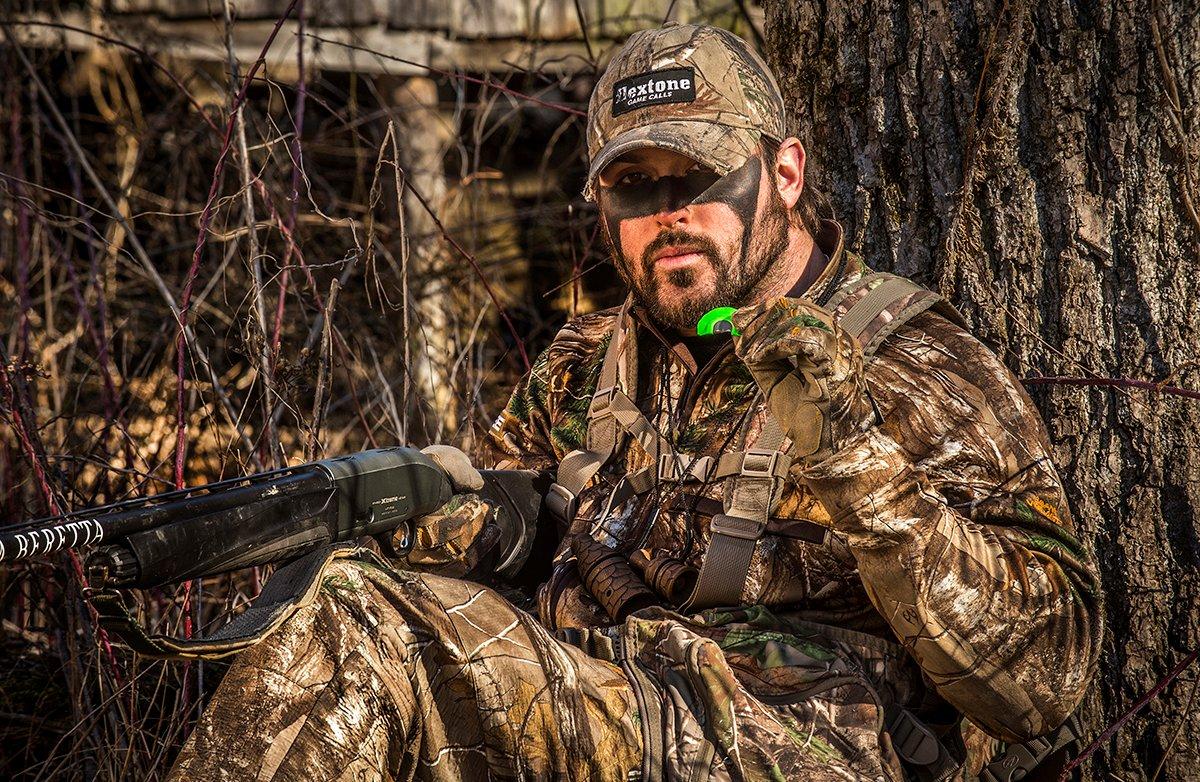Your Turkey Hunting Should Focus on Realism
When it comes to hunting turkeys that have been pressured and educated, Nate Hosie, host of HeadHunters TV and a Realtree pro staffer, has one overriding strategy: Realism.

Born and raised in the mountains of Pennsylvania, Hosie started hunting with his father and grandfather. That love of hunting led to HeadHunters TV, which he co-hosts with Randy Birdsong on The Outdoor Channel, and infiltrates his music as a country artist. His song and music video, Here's to You, has become a branding piece for Realtree.
Hosie's realism strategy for hunting educated turkeys can be broken into five tactical tips that can help win the battle against those frustrating, call-shy and wary toms that make you question what you're doing wrong - or why you're even out in the woods chasing them in the first place.
1. Be a realistic hen.
Realism comes from experience and from practice in the off-season, Hosie said. For folks just beginning to hunt turkeys, it comes from practice, and trial and error.
Turkeys, even those that have been pressured or educated, are going to act differently at different times, he said. You're going to go in there some days and he might be tight-lipped and not want to gobble. No matter what you throw at him he may not open his mouth, period, he said. But, at the same time, turkeys are going to do what turkeys do, he said. They are still looking to breed. They're still out there trying to find a hen or hens, so if you have realism in your calling cadence and your tone, whether he decides to gobble or not, he's coming.
As long as he believes your calling is coming from a real hen, he'll be interested and his drive to breed is always going to outweigh his drive to be smart, Hosie said. If he thinks you're a hen, he's coming.
2. Realism in details.
Learn cadence and tone by listening to real hens in the field; understand turkey language and use it to your advantage, Hosie said.
A lot of times when I'm calling a turkey I know has been pressured, if he'll gobble to me, even just once in a while, I'll yelp really soft, maybe do some clucks and purrs and call through him. What I mean by that is, if I start yelping nice and easy and that turkey starts to gobble, I don't hold up my calls as he gobbles. I call through that turkey, as if I'm saying, 'OK, I heard you but I'm not really that interested in you. I'm calling to whichever of these gobblers around here isn't as skittish as you. Whoever wants to come over here and hold my hand, that's who I'm calling to'.
Some hunters believe that if a turkey gobbles back at you, you should cutt at them really hard, that you need to get them fired up, Hosie said. In some scenarios, I do believe that is true, but I also believe a turkey will work himself up if you're calling realistically. Pay attention to hens, pay attention to their cadence, tone and hesitations. A lot of times hesitation can make your calling as realistic as anything. Hens aren't yelping all the time. There are all kinds of different levels because they are not only yelping, they're listening to what is possibly answering back to them. The right hesitations make your calling very lifelike. Be as lifelike as you can because even on pressured turkeys if they believe you to be a hen, I feel you can break them down and you can be successful.
3. Realism in decoy setup.
Add realism to your hen scenario by using realistic decoys (he uses Flextone decoys), and make them visible, Hosie said. All kinds of different setups can add to realism, he said. So let's say you have a turkey and he might have been pressured. If you can get him to where he can hear you he might at least come out and take a look and see your decoys and now he sees something, not just hears something. Set your decoys where they are visible from a distance, meaning he doesn't come over a lip of a ridge gobbling and, boom, he's face to face with a male decoy, Hosie said. That could freak him out. He's looking for that hen and all the sudden he may have a potential fight on his hands. Set your decoys in a field with a long field of view. If you're in timber, find an open area, like an open flat, where the turkey will feel comfortable approaching, where they can see them a distance through the trees.
4. Adapt realistically, with woodsmanship.
You must constantly adapt, constantly learn, Hosie said. I don't think you ever consider yourself an expert because an animal will humble you at any moment, he said. Ultimately, you can never say this is what he's going to do.
Sometimes pressured turkeys just won't come, then sometimes I've been in areas where turkeys have been pressured and for whatever reason he's just feeling right that day and I cutt down on him and start yelping and he's coming like he's never heard a call in his life, Hosie said. It depends on his mood.
On those days he just won't come, you may have to adapt. Sometimes you have to go to a deer-hunting scenario and go after him, Hosie said. To me it's not the most fun or exhilarating way to hunt turkeys, but it can be successful if you understand what turkeys do during the day.
Understanding them is the key. It's important to be a good caller, but I always, 100-percent believe woodsmanship beats calling any day, he said. No matter how lifelike you sound, you need to understand how to be a woodsman, how to sneak up on animals, what animals do throughout the day; that's a major part of success on pressured birds. You already understand what these birds are doing, you know their routine, you learn the terrain and you can at least set yourself up to play the patience game if you have to, which is probably the hardest game I have to play with turkeys because I don't have patience to wait on them. I got to go find one gobbling.
Run-and-gunning is always a good tactic on pressured turkeys because the more ground you cover the more likely you'll find a not-so-pressured turkey, he said. It may not necessarily help you kill that particular pressured bird, but having enough ground to cover and options if he's not ready to do it that day, you might find one that is. Give yourself more opportunities.
It's like being behind the three-point line. I'm just going to keep shooting until one goes in, he laughed.
5. Enjoy the battle, really.
Hosie said his best tip, whether you're hunting turkey, deer, elk, whatever, is a lot of times the best way to make something happen is to just let it happen.
Get out there and enjoy it, he said. Trust in your calling, trust in your woodsmanship, practice before you go and treat animals with respect by not only being a good shot, but also a good, ethical hunter. Just enjoy it and let it happen. If he's going to be stubborn, enjoy the battle. Enjoy the fight. If he's being a stubborn turkey, don't take it as a loss or unsuccessful hunt. It's a successful hunt. You're in the ball game. You're matching wits with some of the smartest creatures God put on this earth.
When I go in the turkey woods I'm thankful for it. I'm thankful for God's creation and I enjoy it. I enjoy the fight, the battle of sometimes dealing with a stubborn turkey because he makes me better. He makes me a better woodsman, a better caller and a better overall hunter. Just enjoy the hunt and enjoy the battle you're in with that stubborn old longbeard.
Go here for more Realtree turkey hunting. Follow us on Facebook.












































